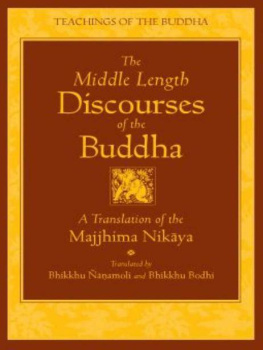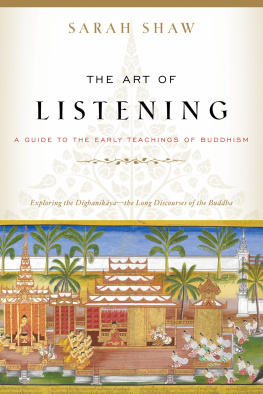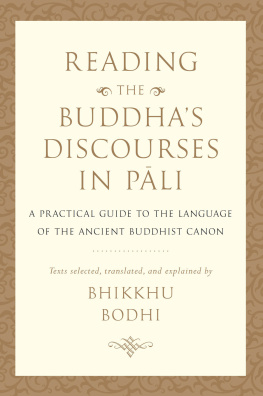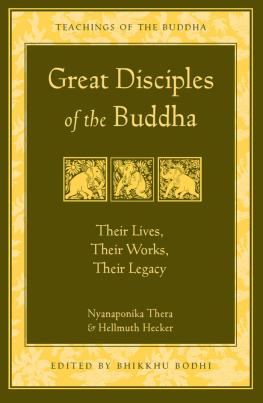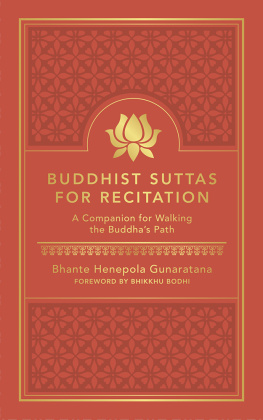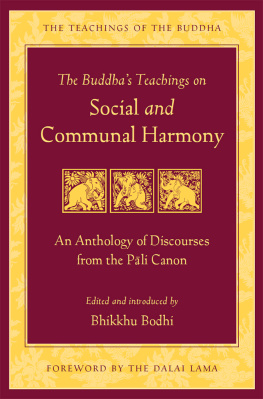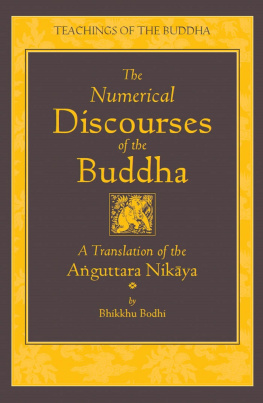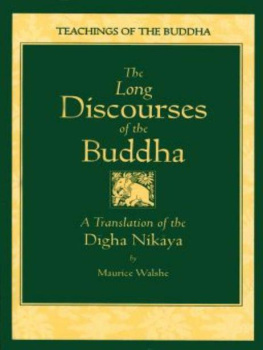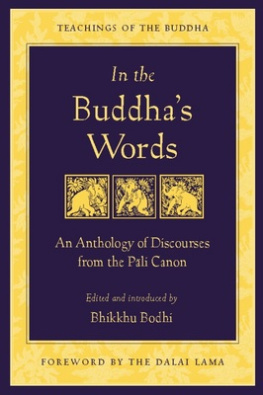Table of Contents
Preface
THE PRESENT WORK OFFERS a complete translation of the Majjhima Nikya , The Middle Length Discourses of the Buddha , one of the major collections in the Sutta Piaka or Basket of Discourses belonging to the Pali Canon. This vast body of scriptures, recorded in the ancient Indian language now known as Pali, is regarded by the Theravda school of Buddhism as the definitive recension of the Buddha-word, and among scholars too it is generally considered our most reliable source for the original teachings of the historical Buddha Gotama.
This translation is an extensively revised version of an original draft translation made by the distinguished English scholar-monk Bhikkhu amoli (19051960). During his eleven years life in the Buddhist Order, passed entirely at the Island Hermitage in south Sri Lanka, Ven. amoli had rendered into English some of the most difficult and intricate texts of Pali Buddhism, among them the encyclopaedic Visuddhimagga . Following his premature death at the age of fifty-five, three thick, hand-bound notebooks containing a handwritten translation of the entire Majjhima Nikya were found among his effects. However, although all 152 suttas of the Majjhima had been translated, the work was obviously still in an ongoing process of revision, with numerous crossouts and overwritings and a fair number of unresolved inconsistencies. The translation also employed an experimental scheme of highly original renderings for Pali doctrinal terms that Ven. amoli had come to prefer to his earlier scheme and had overwritten into the notebooks. He had used this new set of renderings in several of his final publications, offering an explanation for his choices in an appendix to The Minor Readings and The Illustrator of Ultimate Meaning , his translation of the Khuddakapha and its commentary.
In 1976 Bhikkhu Khantiplo made a selection of ninety suttas from the notebooks, which he edited into a fairly consistent and readable version rearranged according to a topical sequence he himself devised. This was published in Thailand in three volumes under the title A Treasury of the Buddhas Words . In this edition Ven. Khantiplo had endeavoured to make as few changes as possible in the original translation by Ven. amoli, though he inevitably found it desirable to replace some of the latters innovative renderings with better-known equivalents, generally choosing the terminology that Ven. amoli had used in The Path of Purification , his excellent translation of the Visuddhimagga .
The present work contains finished translations of all 152 suttas. In editing the ninety suttas selected by Ven. Khantiplo, I have worked from the version found in A Treasury of the Buddhas Words , referring to Ven. amolis notebooks whenever questions arose or problematic passages were encountered. The other sixty-two suttas had to be freshly edited from the notebooks. The translations of all 152 suttas have been checked against the original Pali texts and I hope that all errors and omissions have been rectified.
My aim in editing and revising this material, I must frankly state, has not been to reconstruct the suttas in a way that would conform as closely as possible to the intentions of the original translator. My aim has been, rather, to turn out a translation of the Majjhima Nikya that simultaneously approaches two ideals: first, fidelity to the intended meaning of the texts themselves; and second, the expression of that meaning in an idiom that would be intelligible to a modern reader seeking in the Pali suttas personal guidance in the proper understanding and conduct of life. Terminological exactitude and internal consistency have been important guidelines underlying the endeavour to achieve those ideals, but care has been taken that their pursuit should leave the translation transparent as to the meaning.
To produce a translation of the Majjhima Nikya that is both technically precise and lucid in expression required numerous revisions in the manuscript version. Most were quite minor but a few were substantial. Numerous alterations were made in the rendering of Pali doctrinal terms, most of Ven. Khantiplos changes having been incorporated. In place of Ven. amolis novel renderings I have in most cases returned to the clearer and better established terminology he employed in The Path of Purification . When doubts arose I always turned for help to Ven. Nyanaponika Mahthera, whose wise advice helped to steer this translation closer towards its two guiding ideals. The handling of several important technical terms is discussed at the end of the Introduction, to which is attached a list showing the terminological changes that were made for this edition. By consulting the list the reader can obtain some idea of how the manuscript translation read. A glossary in the back gives the English renderings used for the major Pali doctrinal terms found in the Majjhima Nikya as well as Pali words and meanings not included in the Pali Text Societys Pali-English Dictionary . The subject index also includes, for most entries, the Pali term after its chosen English rendering. Botanical names that could not be easily rendered by familiar English equivalents have been left untranslated.
Ven. amolis translation was based primarily on the Pali Text Societys roman-script edition of the Majjhima Nikya, published in three volumes, the first edited by V. Trenckner (1888), the second two by Robert Chalmers (1898, 1899). This edition was also used to check the translation, but on problematic passages I consulted as well two other editions: the Burmese Buddhassana Samitis Sixth Buddhist Council edition in Burmese script and the Sinhala-script Buddha Jayanti edition published in Sri Lanka. Instances are not unusual where the reading in one or the other of these editions was preferred to that of the PTS edition, though only occasionally are these mentioned in the notes. Seldom too do the notes refer to I. B. Horners long-standing English translation of the Majjhima Nikya, The Collection of the Middle Length Sayings , with which I sometimes compared Ven. amolis translation. Since the first volume of that translation was published in 1954, and the next two in 1957 and 1959, while Ven. amolis manuscript indicates that he did his revised translation between 1953 and 1956, it seems unlikely that he had consulted Horners version in preparing his own; at most, he might have had access to the first volume after he had completed his first volume.
The text of the translation is divided into numerical sections. These divisions were introduced by Ven. amoli into his manuscript version of the suttas and are not found in the PTS edition of the Majjhima Nikya. Sometimes, when logic seemed to dictate it, I have made minor alterations in the divisions. The section numbers are included in the sutta references in the Introduction, Notes, and Indexes. Thus, for example, a reference to MN 26.18 means Majjhima Sutta No. 26, section 18.
The numbers at the top of the pages refer to the volume and page number of the PTS edition of the Majjhima Nikya, as do the bracketed numbers embedded in the text (except for MN 92 and MN 98, wherein the numbers refer to the PTS edition of the Sutta Nipta).
The Introduction aims to provide the reader with a thorough study guide to the Majjhima Nikya by systematically surveying the principal teachings of the Buddha contained in this collection along with references to the suttas where fuller expositions of those teachings can be found. More elementary information on the Pali Canon and on Pali Buddhism in general will be found in Maurice Walshes introduction to his recent translation of the complete Dgha Nikya, Thus Have I Heard , which the present publication is intended to parallel. As a way of easing the readers entrance into the canonical texts themselves, a summary of the Majjhimas 152 suttas follows the Introduction.

